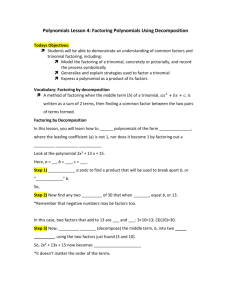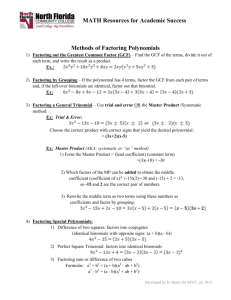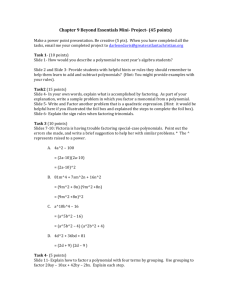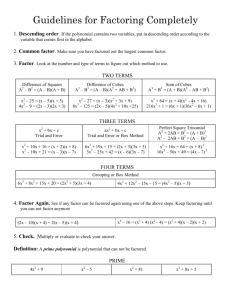Factoring Polynomials - Tutoring and Writing Centers
advertisement
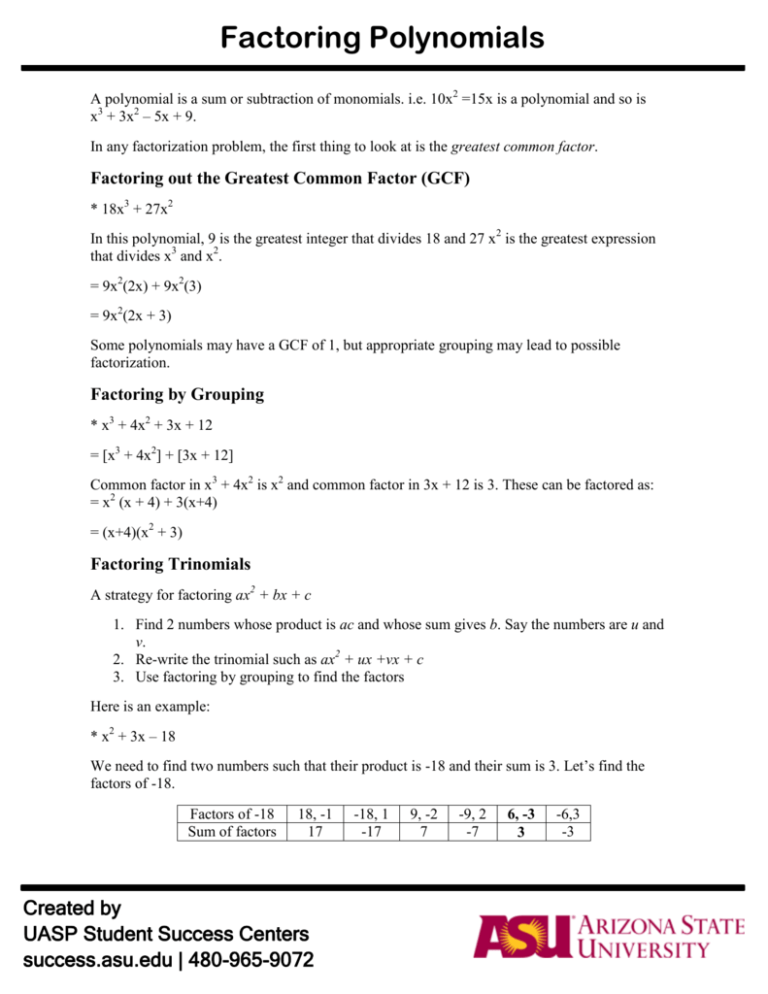
Factoring Polynomials A polynomial is a sum or subtraction of monomials. i.e. 10x2 =15x is a polynomial and so is x3 + 3x2 – 5x + 9. In any factorization problem, the first thing to look at is the greatest common factor. Factoring out the Greatest Common Factor (GCF) * 18x3 + 27x2 In this polynomial, 9 is the greatest integer that divides 18 and 27 x2 is the greatest expression that divides x3 and x2. = 9x2(2x) + 9x2(3) = 9x2(2x + 3) Some polynomials may have a GCF of 1, but appropriate grouping may lead to possible factorization. Factoring by Grouping * x3 + 4x2 + 3x + 12 = [x3 + 4x2] + [3x + 12] Common factor in x3 + 4x2 is x2 and common factor in 3x + 12 is 3. These can be factored as: = x2 (x + 4) + 3(x+4) = (x+4)(x2 + 3) Factoring Trinomials A strategy for factoring ax2 + bx + c 1. Find 2 numbers whose product is ac and whose sum gives b. Say the numbers are u and v. 2. Re-write the trinomial such as ax2 + ux +vx + c 3. Use factoring by grouping to find the factors Here is an example: * x2 + 3x – 18 We need to find two numbers such that their product is -18 and their sum is 3. Let’s find the factors of -18. Factors of -18 Sum of factors 18, -1 17 Created by UASP Student Success Centers success.asu.edu | 480-965-9072 -18, 1 -17 9, -2 7 -9, 2 -7 6, -3 3 -6,3 -3 Factoring Polynomials Our desired numbers are 6 and -3. We will now re-write our trinomial: x2 + 6x – 18 = [x2 + 6x] – [3x + 18] = x(x + 6) -3(x+6) = (x – 3)(x+6) Let’s look at another example whose leading coefficient is not 1: * 8x2 – 10x – 3 We need to find two numbers such that their product is -24 and their sum is -10. Let’s find the factors of -24. Factors of -24 Sum of Factors 24, -1 23 -24, 1 -23 12, -2 10 -12, 2 -10 Our desire numbers are -12 and 2. We will now re-write our trinomial: 8x2 – 12x + 2x – 3 = [8x2 -12x] + [2x – 3] = 4x(2x – 3) + 1(2x-3) = (4x + 1)(2x -3) Created by UASP Student Success Centers success.asu.edu | 480-965-9072 8, -3 5 -8, 3 -5 6, -4 2 -6, 4 -2 Factoring Polynomials A Strategy for Factoring a Polynomial 1. If there is a common factor, factor out the GCF. 2. Determine the number of terms in the polynomial and try factoring as follows a. If there are two terms, then can the binomial be factored by any of the special forms? i.e. Difference of two squares a2 – b2 = (a + b)(a – b) Sum of two cubes a3 + b3 = (a + b)(a2 – ab + b2) Difference of two cubes a3 + b3 = (a - b)(a2 + ab + b2) b. If there are three terms, then is the trinomial a perfect square trinomial? i.e. a2 + 2ab + b2 = (a + b)2 and a2 - 2ab + b2 = (a - b)2 If not, try the method shown earlier for factorization of trinomials. c. If there are four or more terms, try factoring by grouping. 3. Check to see if any factors with more than one term in the factored polynomial can be factored further. If so, factor completely. Let’s look at another example: * 2x3 + 8x2 + 8x Step 1: The GCF is 2x, therefore the polynomial can be written as: 2x(x2 +4x +4) Step 2: Now we have to factor a polynomial with three terms and it looks like a perfect square trinomial. Therefore, (x2 + 4x + 4) can be factored as (x + 2)2 Step 3: Check to see if factors can be factored further. If not, you have reached the final answer i.e. 2x3 + 8x2 + 8x = 2x (x + 2)2 Created by UASP Student Success Centers success.asu.edu | 480-965-9072

